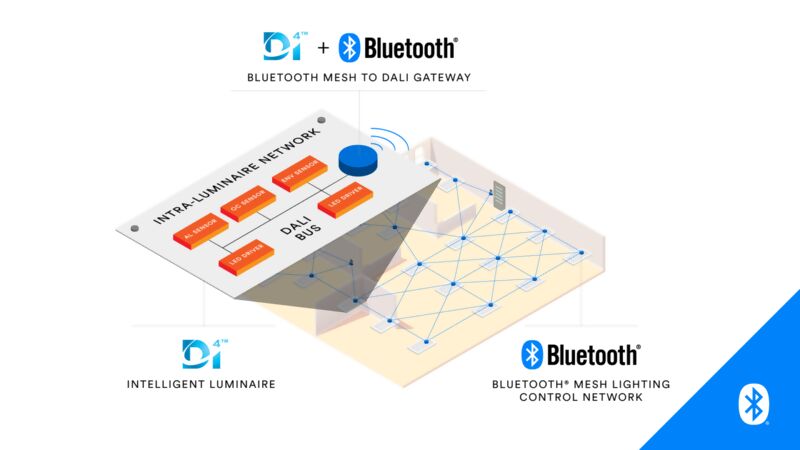Bluetooth Mesh – reliable networking for lighting and building automation with certainty
Bluetooth is already firmly established in the field of audio streaming and fitness wearables. Bluetooth Mesh adds a new area: building automation.
A small insertion at the beginning: «Bluetooth Mesh» is not synonymous with «BLE Mesh». The term BLE Mesh can be seen as an umbrella term for all previous proprietary approaches to realise a mesh network with the BLE standard. The only thing Bluetooth Mesh uses from BLE Mesh is the message carrier, the so-called «bearer».
A big advantage is that we carry a perfect user interface around with us every day, which is already Bluetooth Mesh capable thanks to exactly this commonality with BLE Mesh. This circumstance may be convenient, but it has probably also caused headaches for some developers during the development of the Bluetooth Mesh standard. This is mainly when it comes to protection against unauthorised access. This brings us to the next topic.
Security is a top priority
Security is an extremely important issue in wireless communication, and the seriousness increases with the amount of networked nodes and different applications that are supported.

Figure 1 Visualisation IoT (AdobeStock)
If the technology is simple, limited to lighting control and cannot be combined with any other applications, an attack on such a network poses relatively little risk. However, an attack can be devastating if the network is responsible not only for lighting control but also for critical functions such as air conditioning or access systems.
However, the trend is going exactly in this direction: different sectors are being combined more and more. This is the core idea of IoT, one wants to get away from isolated solutions where each application requires its own, isolated communication network.
Since the Bluetooth Mesh standard is comparatively young, this aspect could be adequately taken into account from the very beginning. The newly rolled up concept resulted in an architecture that is provided with state of the art security measures from the ground up. The Bluetooth Mesh Profile Standard is open, anyone can view it and critically question it. The Bluetooth SIG also offers a web portal for reporting security vulnerabilities found in Bluetooth.

Figure 2 Visualisation Security (iStockphoto)
Other wireless mesh standards that have been on the market for longer have had to grow with setbacks. Security in wireless standards is a sensitive issue. There is a lot of information on the internet, but it should be read with appropriate caution.
What is indisputable, however, is what has happened. Security keys have already been cracked and published on the web in various forums. Product manufacturers have had to question the security of their own products. If the implementation of security features is not defined as «mandatory» by the standard, the result is a jumble of products with different levels of security.
Bluetooth, on the other hand, has cleverly tackled this problem and successfully eliminated it by rigidly anchoring the protective mechanisms in the mesh standard. This means that implementation is mandatory, otherwise there is no Bluetooth stamp on the product! However, Bluetooth is not always synonymous with «secure». For example, the BLE standard offers optional security features. In contrast to mesh, here there is the possibility for the respective trade-off per design. This also makes sense because security usually comes at the expense of convenience and with the traditional point-to-point connection of Bluetooth, the potential for damage in the event of an attack is much smaller.
Bluetooth Mesh technology
Bluetooth Mesh is the choice when it comes to scalability and reliability. Properties that are particularly important for lighting control. Especially when transmitter and receiver are not in close proximity and messages need to be exchanged over longer distances, such as in an office building, the advantages of the mesh network can be used.
But how does Bluetooth Mesh work?
Bluetooth Mesh uses a so-called «managed flood message relay» procedure. This means that all participants in the network - the nodes - receive the same message and can also forward it. This makes it possible to reach several thousand participants and at the same time guarantee a high performance and reliability of the network.
The process can be compared to messaging services from social media. All nodes can send messages to the network («publish») and subscribe to messages («subscribe»). All nodes in a group that are interested in the status of the light value, for example, can subscribe to these messages. Sensors, switches and luminaires communicate directly with each other. The concept of decentralisation eliminates the need for a central control unit, which means that even if one or more nodes fail, the lighting control continues to function.
The efficient data transmission with Bluetooth Mesh reduces the load on the radio network and guarantees high reliability. The size of the so-called payload of the messages to be transmitted is optimised to generate as little radio traffic as possible within the network. For example, if you want to set the light level, it is sufficient to send the command «Light Lightness Set» (2 bytes), the «Lightness Level» (2 bytes) and a «Transaction Identifier» (1 byte: new message or new transmission). If you want to set the lightness level to the maximum, the message is: 0x82 4C FF FF 00.

Figure 3 Visualisation Message Addressing (Source: Bluetooth SIG)
DALI and Bluetooth Mesh
The standardised radio protocol of the Bluetooth SIG is used to connect sensors within a network. Bluetooth technology follows a full-stack approach. This means that technical specifications have been developed from the low-level (radio part) to the high-level (application layer). So-called models were defined that describe how a sensor or a luminaire should behave. This ensures that a motion detector purchased 30 years ago will still be compatible in the future. Bluetooth provides the necessary qualification tools and thus guarantees global interoperability.
For controlling LED drivers, the DALI (Digital Addressable Lighting Interface) standard is widely used and is thus the perfect complement to Bluetooth Mesh. The DALI Alliance (DiiA) has published specifications that range from colour control and dimming levels to diagnostic data such as energy consumption and power consumption. Many well-known manufacturers of LED drivers support the standard and thus guarantee manufacturer-independent compatibility.
SENSOTEC NET sensors from STEINEL Solutions AG support both standards: SIG's Bluetooth Mesh and DiiA's DALI standard. The sensors interact in a network as a Bluetooth Mesh-to-DALI gateway. This makes applications such as automatic and demand-responsive lighting control and energy monitoring possible today. And for the future, the infrastructure already exists for new use cases such as asset tracking or indoor navigation.

Figure 4 DALI and Bluetooth (Source: Bluetooth SIG)
Recommended Case Studies

«Bluetooth Mesh opens the door to the future as a basis for IoT projects and offers countless application possibilities in the areas of building automation, intelligent lighting systems, Industry 4.0, to name just a few buzzwords.»









